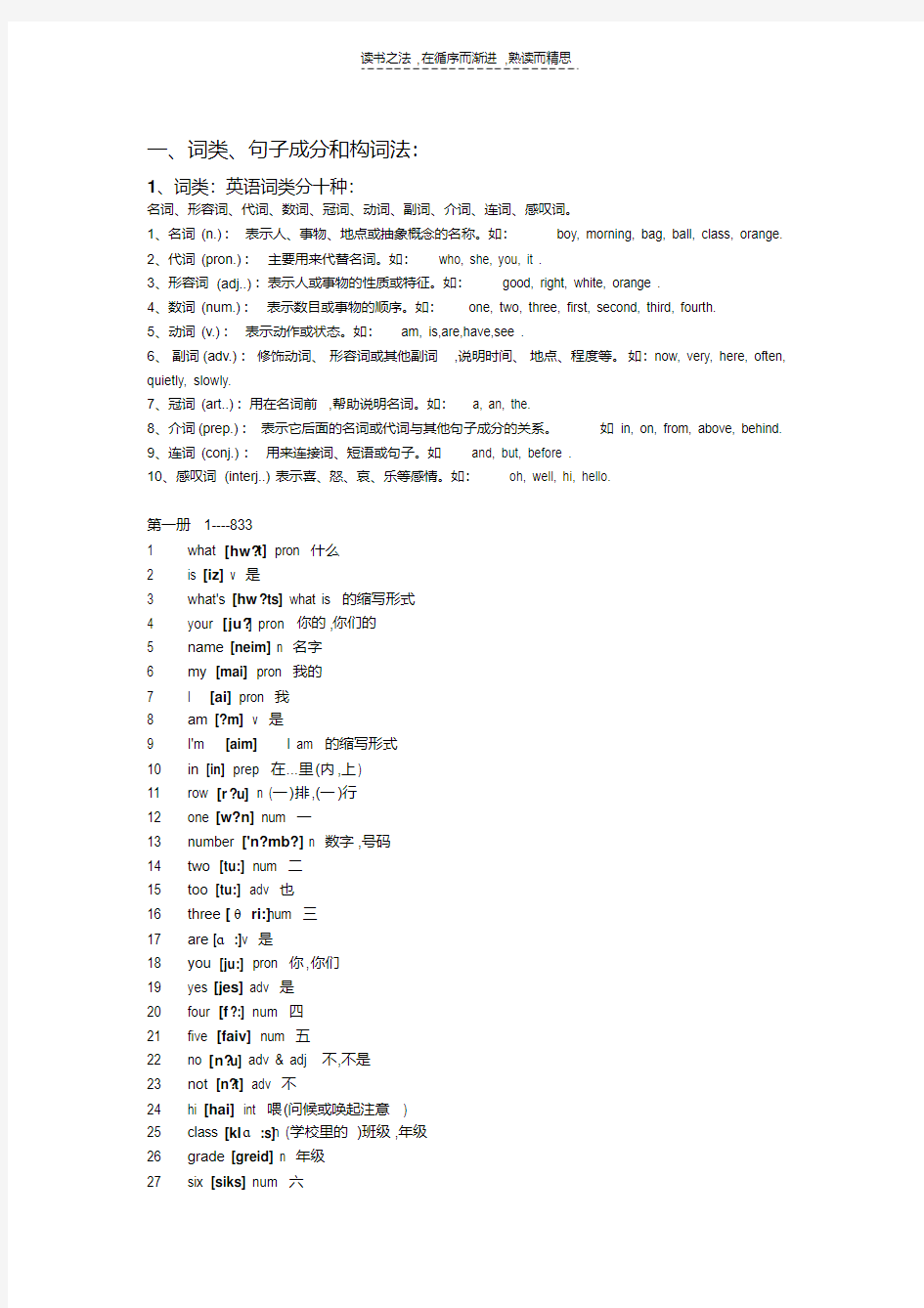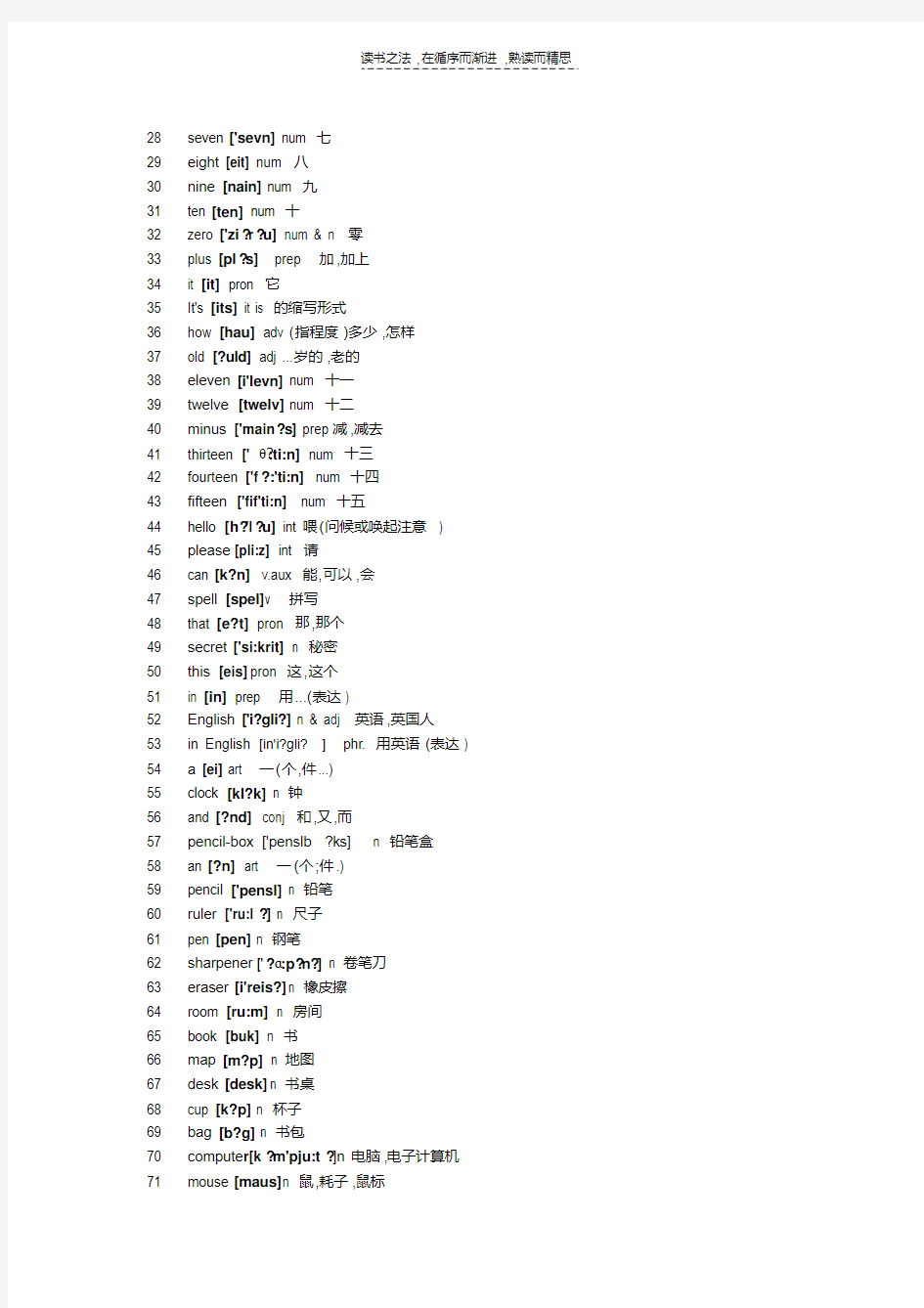最新初中英语单词,语法


一、词类、句子成分和构词法:
1、词类:英语词类分十种:
名词、形容词、代词、数词、冠词、动词、副词、介词、连词、感叹词。
1、名词(n.):表示人、事物、地点或抽象概念的名称。如:boy, morning, bag, ball, class, orange.
2、代词(pron.):主要用来代替名词。如:who, she, you, it .
3、形容词(adj..):表示人或事物的性质或特征。如:good, right, white, orange .
4、数词(num.):表示数目或事物的顺序。如:one, two, three, first, second, third, fourth.
5、动词(v.):表示动作或状态。如:am, is,are,have,see .
6、副词(adv.):修饰动词、形容词或其他副词,说明时间、地点、程度等。如:now, very, here, often, quietly, slowly.
7、冠词(art..):用在名词前,帮助说明名词。如:a, an, the.
8、介词(prep.):表示它后面的名词或代词与其他句子成分的关系。如in, on, from, above, behind.
9、连词(conj.):用来连接词、短语或句子。如and, but, before .
10、感叹词(interj..)表示喜、怒、哀、乐等感情。如:oh, well, hi, hello.
第一册1----833
1 what [hw?t] pron 什么
2 is [iz] v 是
3 what's [hw?ts] what is 的缩写形式
4 your [ju?] pron 你的,你们的
5 name [neim] n 名字
6 my [mai] pron 我的
7 I [ai] pron 我
8 am [?m] v 是
9 I'm [aim] I am 的缩写形式
10 in [in] prep 在...里(内,上)
11 row [r?u] n (一)排,(一)行
12 one [w?n] num 一
13 number ['n?mb?] n 数字,号码
14 two [tu:] num 二
15 too [tu:] adv 也
16 three[θri:] num 三
17 are [ɑ:] v 是
18 you [ju:] pron 你,你们
19 yes [jes] adv 是
20 four [f?:] num 四
21 five [faiv] num 五
22 no [n?u] adv & adj 不,不是
23 not [n?t] adv 不
24 hi [hai] int 喂(问候或唤起注意)
25 class [klɑ:s] n (学校里的)班级,年级
26 grade [greid] n 年级
27 six [siks] num 六
28 seven ['sevn] num 七
29 eight [eit] num 八
30 nine [nain] num 九
31 ten [ten] num 十
32 zero ['zi?r?u] num & n 零
33 plus [pl?s]prep 加,加上
34 it [it] pron 它
35 It's [its] it is 的缩写形式
36 how [hau] adv (指程度)多少,怎样
37 old [?uld] adj ...岁的,老的
38 eleven [i'levn] num 十一
39 twelve [twelv] num 十二
40 minus ['main?s] prep减,减去
:ti:n] num 十三
41 thirteen ['θ?
42 fourteen ['f?:'ti:n] num 十四
43 fifteen ['fif'ti:n] num 十五
44 hello [h?'l?u] int喂(问候或唤起注意)
45 please [pli:z] int 请
46 can [k?n] v.aux 能,可以,会
47 spell [spel] v 拼写
48 that [e?t] pron 那,那个
49 secret ['si:krit] n 秘密
50 this [eis] pron 这,这个
51 in [in] prep 用...(表达)
52 English['i?gli?] n & adj 英语,英国人
53 in English[in'i?gli?]phr. 用英语(表达)
54 a [ei] art 一(个,件...)
55 clock [kl?k] n 钟
56 and [?nd] conj 和,又,而
57 pencil-box['penslb?ks]n 铅笔盒
58 an [?n] art 一(个;件.)
59 pencil ['pensl] n 铅笔
60 ruler ['ru:l?] n 尺子
61 pen [pen] n 钢笔
62 sharpener ['?ɑ:p?n?] n 卷笔刀
63 eraser [i'reis?] n 橡皮擦
64 room [ru:m] n 房间
65 book [buk] n 书
66 map [m?p] n 地图
67 desk [desk] n 书桌
68 cup [k?p] n 杯子
69 bag [b?g] n 书包
70 compute r[k?m'pju:t?]n电脑,电子计算机
71 mouse [maus]n 鼠,耗子,鼠标
72 bed [bed] n 床
73 keyboard ['ki:b?:d] n 键盘
74 isn't ['iznt]is not 的缩写形式
75 pear [p??] n 梨
76 cake [keik] n 蛋糕,饼,糕
77 banana [b?'nɑ:n?] n 香蕉
78 apple ['?pl] n 苹果
79 orange ['?:rind?] n 橙子,橘子
80 egg [eg] n 蛋
81 bike [baik] n 自行车
82 bus [b?s] n 公共汽车
83 car [kɑ:] n 汽车,小汽车
84 jeep [d?i:p] n 吉普车
85 Chinese['t?ai'ni:z]adj中国的,中国人的;n 中国人,汉语
n 中国人,汉语
1. 动词的时态
11.1 一般现在时的用法
1)经常性或习惯性的动作,常与表示频腮度的时间状语连用。时间状语:every…, sometimes, at…, on Sunday。例如:
I leave home for school at 7 every morning. 每天早上我七点离开家。
2)客观真理,客观存在,科学事实。例如:
The earth moves around the sun. 地球绕太阳转动。
Shanghai lies in the east of China. 上海位于中国东部。
3)表示格言或警句。例如:
Pride goes before a fall. 骄者必败。
注意:此用法如果出现在宾语从句中,即使主句是过去时,从句谓语也要用一般现在时。
例:Columbus proved that the earth is round. 哥伦布证实了地球是圆的。
